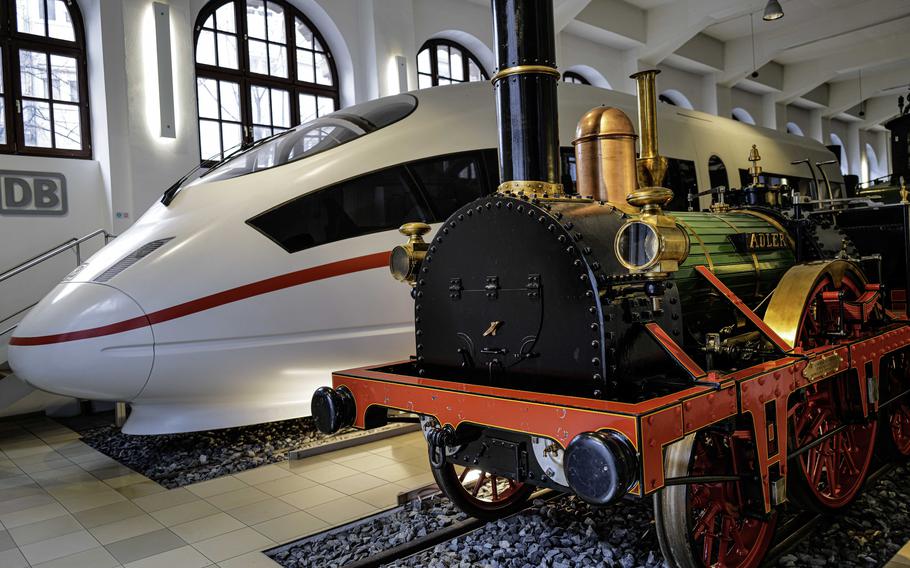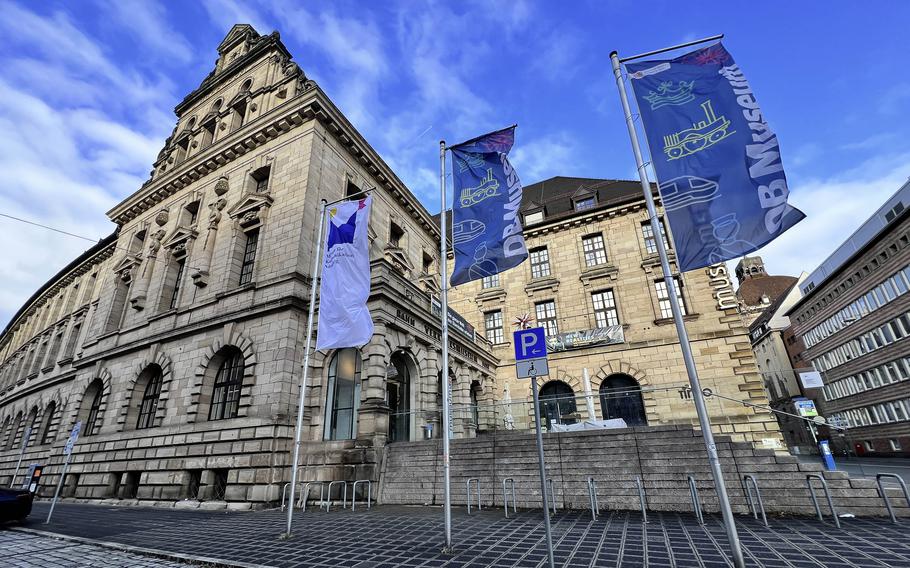
The Adler, or Eagle, the first commercial steam locomotive to roll through Germany, stands next to a high-speed Intercity Express train at the German Railway Museum in Nuremberg. Imported from England, the Adler transported passengers and cargo and reached a maximum speed of 40 mph. (Alexander Riedel/Stars and Stripes)
From a whirlwind backpacking trip in our early 20s that we prepped for with little more than a Eurail ticket, to spontaneous weekend getaways today, many adventures for my wife and me have started among the bustle of a busy train station.
While we love the comfort and convenience of the train, as long as our ride is on time we rarely pause to consider the engineering marvel that is the conveyance itself.
On a recent afternoon, though, as we sought shelter from a cold rain at the Nuremberg Christmas market, we found ourselves stepping into the Deutsche Bahn Museum.
Amid the city’s impressive tapestry of historic and cultural landmarks, a train museum did not initially make our itinerary. However, this unassuming gem, with its troves of locomotive lore, merits more than a mere footnote during a trip to Nuremberg.
Starting with the Adler, or Eagle, an English-made steam engine, which heralded a new era of travel in 1835, the museum weaves a tale of technological triumphs and societal shifts.
The Adler’s first humble 4-mile journey from downtown Nuremberg to nearby Fuerth propelled not only the first German train passengers but also an age of industrial momentum that continues to this day.
This revolution was not confined to Germany, of course. Across the Atlantic, railroads were stitching together the vast American landscape, transforming both continents in profound ways.
In Germany, trains reshaped urban growth, enabling the sprouting of suburbs and industrial zones connected by the rhythmic comings and goings of commuter trains and coal wagons.
Yet the museum does not shy away from the darker chapters of German railway history. It meticulously documents the use of trains in World War I to rapidly transport troops and materiel.
The museum confronts the Nazi period with a solemn candor, displaying films and artifacts that recount how the Reichsbahn was co-opted into facilitating the Holocaust.
Moving through time, we entered a vibrantly red room chronicling the German railway’s transformation into the Deutsche Bahn of today.
The advent of the Intercity Express and implementation of digital innovations like online tickets marked a new chapter in train travel history for Europe.
For enthusiasts and casual visitors alike, the museum’s collection of locomotives and trains, ranging from miniature models to full-size behemoths, is well worth the visit.
The Adler, for instance, stands juxtaposed next to a sleek ICE train, illustrating the evolutionary leap from 40 mph to 186 mph. Several other exhibits in two halls and an outdoor yard invite visitors to get an up-close look at old and new technology.
Among these mechanical marvels, King Ludwig II’s opulent Salonwagen stands out. After our visit to Neuschwanstein Castle this summer, witnessing this “Neuschwanstein on wheels,” with its ceiling painting and gilded furniture, felt like peering into the king’s fanciful world, a blend of luxury and whimsy.
The museum’s playful heart lies in its renowned collection of more than 2,000 model trains from matchbox-size miniatures to giant models of 1:5 scale.
In its room-filling modellarium, a miniature Germany unfolds, complete with historic cityscapes, soccer pitches and fairgrounds. A full rail system covers all kinds of trains traversing the equivalent of five football fields of tracks.
This nutshell of a world allows museum staff to introduce visitors to the intricate logistics of real-world rail operations.
While not all exhibits were translated into English, QR codes provided an excellent English language app with audio guide and map, and time in the museum halls passed all too quickly.
What began as a brief escape from the rain transformed into an entertaining two-hour exploration. We delved into the stories of travelers past and marveled at the technological strides in railway transport.
It may even have made me a little bit more forgiving of the inevitable next delay of a DB train in the future.

The facade of the Deutsche Bahn Museum in Nuremberg, Germany, on Dec. 20, 2023. The museum displays railway history on three floors inside as well as in an external exhibit hall and rail yard. (Alexander Riedel/Stars and Stripes)
riedel.alexander@stripes.com Twitter: @lexRiedel
On the QT
Address: Lessingstrasse 6, Nuremberg, Germany
Times: Year-round, 9 a.m.-5 p.m. Tuesday-Friday; 10 a.m.-6 p.m. weekends and holidays. Closed Mondays.
Cost: Entry is 9 euros per adult, 5 euros for children 6-17 years old, and free for children under 6.
Information: Online: dbmuseum.de/en/nuremberg